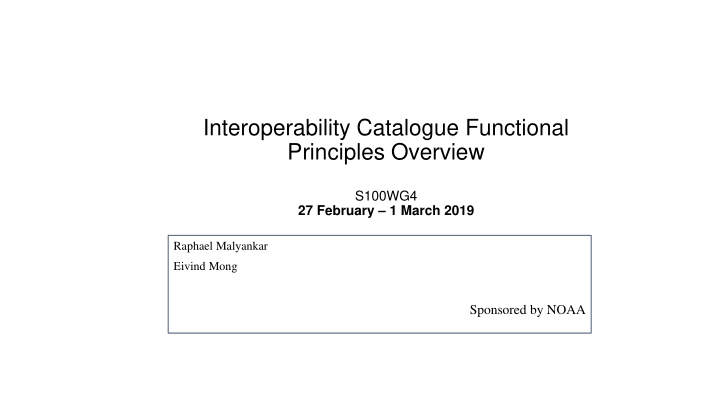



Interoperability Catalogue Functional Principles Overview S100WG4 27 February – 1 March 2019 Raphael Malyankar Eivind Mong Sponsored by NOAA
Motivation for this white paper • SHOM made a comment during reviews of S-98 (Interoperability Specification) on the nature of the document being highly technical and not including an overview of the purpose; FR General ge Interoperability principles Clarify certain principles of comment interoperability beyond their technical description • To address this comment, a white paper was drafted and it provides high level information about S-98. • The white paper is written as a foreword to S-98, but can be amended to become an independent document.
Content • Background • Principles of interoperability • Purpose • Functional overview • Administration aspects of interoperability • Data Encoding Guide • Implementation of interoperability support
Content - Background • A paragraph to explain the current situation with ECDIS interoperability and why there is a need for a common method in S- 100 ECDIS. • Also giving the background of the founding principles for the specification; • The interoperability catalogue specification has been created using input from a survey by S-100WG of experts in ECDIS, government participants, and S- 100-based product specification. The survey results were used to create the framework which was then validated by review by members of S-100WG. Subsequently the overall specification was created.
Content - Principles of interoperability • High level description of basic principles of interoperability in ECDIS. • Talks about the relationship between ENC and additional layers. • I.E. two types of layers; • 1 – additional information • 2 – enhancements to information already in ENC. • Touches on rules that governing interoperability.
Content - Purpose • Explains that the interoperability specification is developed as a framework for capturing interoperability rules for use in ECDIS. • Includes descriptions of the four levels of interoperability and how these are of increasing degree of interoperability. Also clarifies that Levels 3 and 4 are not yet fully elaborated. Level 2 Level 3 Level 4 Type-based Level 1 selectivity Feature Spatial and feature Interleaving hybridization operations class replacement
Content - Functional overview • High level description of the functional aspects of IC. • Gives a high level overview of the IC. • Includes a brief on the IC maintenance process.
Content - Administration aspects of interoperability • Explains the need for harmonization and cooperation between teams that develop and maintain in scope product specifications that will be used in the interoperability concept. • Section stresses that specifications that are in scope for the IC, are part of the same eco system and the management process needs to reflect this.
Content - Data Encoding Guide • Gives justification for the encoding guidance included in the interoperability specification.
Content - Implementation of interoperability support • Gives a brief overview of different parts of implementation guidance that the Interoperability Specification includes. • Mentions the need to consider software quality when implementing the IC support in an ECDIS, and references IMO guidelines for software quality as the main principles to follow.
Questions?
Recommend
More recommend